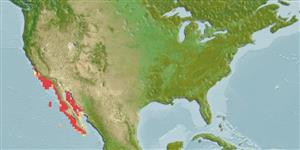Common names from other countries
>
Gadiformes (Cods) >
Macrouridae (Grenadiers or rattails)
Etymology: Coelorinchus: Greek, koilos = a hollow + Greek, rhyngchos = jaw (Ref. 45335).
More on author: Gilbert.
Environment: milieu / climate zone / depth range / distribution range
Ecologia
marinhas bentopelágico; não migratória; intervalo de profundidade 180 - 300 m (Ref. 9315). Deep-water; 37°N - 22°N, 123°W - 107°W (Ref. 1371)
Eastern Pacific: southern California and northern Gulf of California; probably also in outer slope waters of Baja California and mainland Mexico.
Tamanho / Peso / Idade
Maturity: Lm ? range ? - ? cm
Max length : 34.0 cm TL macho/indeterminado; (Ref. 1371)
Descrição suscinta
Morfologia | Morfometria
Espinhos dorsais (total): 2; Raios dorsais (total): 7-9; Espinhos anais 0. Body tapering to a point posteriorly from behind the origin of the first dorsal fin. Head large; the eyes also large; the snout relatively short, its antero-lateral margin incompletely supported by bone, its terminal scute broad, blunt. Head ridges strong but not especially spiny; the underside of the snout, the ventral margins on the suborbital and mandible naked. Light organ large, lens-shaped. Overall color swarthy to grayish; the fins dusky to black; the mouth pallid; the gill cavity blackish, paler inwardly (Ref. 1371). A large, black, naked fossa midventrally on chest; anus at origin of the anal fin. Smooth second dorsal spine at all sizes (Ref. 26798). Branchiostegal rays: 6-6 (Ref. 36385).
Stomach contents reveal the ingestion of shrimps and other crustaceans (Ref. 9315). Oviparous, with planktonic larvae (Ref. 36385).
Ciclo de vida ou comportamento de acasalamento
Maturidade | Reprodução | Desova | Ovos | Fecundidade | Larvas
Cohen, D.M., T. Inada, T. Iwamoto and N. Scialabba, 1990. FAO species catalogue. Vol. 10. Gadiform fishes of the world (Order Gadiformes). An annotated and illustrated catalogue of cods, hakes, grenadiers and other gadiform fishes known to date. FAO Fish. Synop. 125(10). Rome: FAO. 442 p. (Ref. 1371)
Status na Lista Vermelha da UICN (Ref. 130435)
CITES (Ref. 128078)
Not Evaluated
Ameaça para os humanos
Harmless
Uso pelos humanos
Pescarias: pouco comercial
Mais informação
Idade/TamanhoCrescimentoPeso-comprimentoComprimento-comprimentoFrequências de comprimentoMorfometriaMorfologiaLarvasDinâmica larvalRecrutamentoAbundância
ReferênciasAquaculturaPerfil para aquaculturaEstirpesGenéticaElectrophoresesHereditariedadeDoençasProcessamentoConversão de massa
Ferramentas
Relatórios especiais
Baixar XML
Fontes da internet
Estimates based on models
Preferred temperature (Ref.
115969): 8 - 12.8, mean 11.5 (based on 10 cells).
Índice de diversidade filogenética (Ref.
82804): PD
50 = 0.5000 [Uniqueness, from 0.5 = low to 2.0 = high].
Bayesian length-weight: a=0.00251 (0.00128 - 0.00492), b=3.19 (3.03 - 3.35), in cm Total Length, based on LWR estimates for this Genus-body shape (Ref.
93245).
Nível Trófico (Ref.
69278): 3.6 ±0.55 se; based on food items.
Resiliência (Ref.
120179): Baixo, tempo mínimo de duplicação da população 4,5 - 14 anos (Preliminary K or Fecundity.).
Fishing Vulnerability (Ref.
59153): Low vulnerability (24 of 100).
